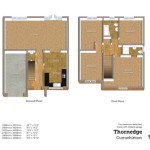Essential Aspects of Cob House Planning Permission
Building a cob house can be a rewarding experience, but it's essential to ensure that you have the necessary planning permission in place. This guide will provide an overview of the key factors you need to consider when applying for planning permission for a cob house.
1. Local Planning Policies
The first step is to check the local planning policies for your area. These policies will set out the general requirements for building a new house, including any specific restrictions or conditions that may apply to cob houses.
2. Site Selection
The location of your proposed cob house will also play a role in the planning process. Local authorities will consider factors such as the impact on the surrounding area, access to utilities, and potential flooding risks.
3. Building Regulations
Cob houses must meet the same building regulations as other types of houses. These regulations cover aspects such as structural stability, fire safety, and energy efficiency. You may need to hire a qualified surveyor to ensure that your cob house meets the required standards.
4. Design and Appearance
Local authorities will also consider the design and appearance of your cob house. This includes factors such as the size, shape, and materials used. Cob houses are typically designed in a traditional style, but you may be able to incorporate some modern elements into your design.
5. Environmental Impact
The environmental impact of your cob house will also be a consideration. Local authorities will want to ensure that the construction and operation of your house will not have a negative impact on the environment.
6. Application Process
Once you have gathered all the necessary information, you can begin the planning application process. This will involve submitting a detailed application to the local authority, including plans, drawings, and supporting documentation.
7. Decision-Making Process
Local authorities will typically have a set period of time to make a decision on your planning application. They will consider all the factors discussed above before making their final decision.
8. Approval and Conditions
If your planning application is approved, you will typically be granted planning permission subject to certain conditions. These conditions may include requirements to use specific materials or construction methods, or to mitigate any potential environmental impacts.
Conclusion
Applying for planning permission for a cob house can be a complex process, but by following the steps outlined in this guide, you can increase your chances of success. It is important to remember that every application is different, so it is always advisable to seek professional advice from a qualified planning consultant if you are unsure about any aspect of the process.

How To Get Planning Permission For An Off Grid Self Build Home

9 Tips For Cob House Building Code Approval This

Cob Houses The Self Build Guide

9 Tips For Cob House Building Code Approval This

Farmer Builds A House For Just 150 Using Materials He Found In Skips And The Cur Tenant Pays Their Milk Daily Mail

Cob Houses Design For Me

What About Cob Building Codes And Permit Requirements

Mud Building Blog The Home

Cob Houses Design For Me

Submitting Your Planning For Approval The Self Build Guide








